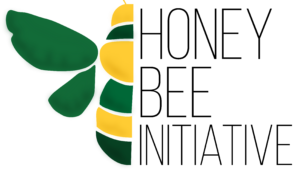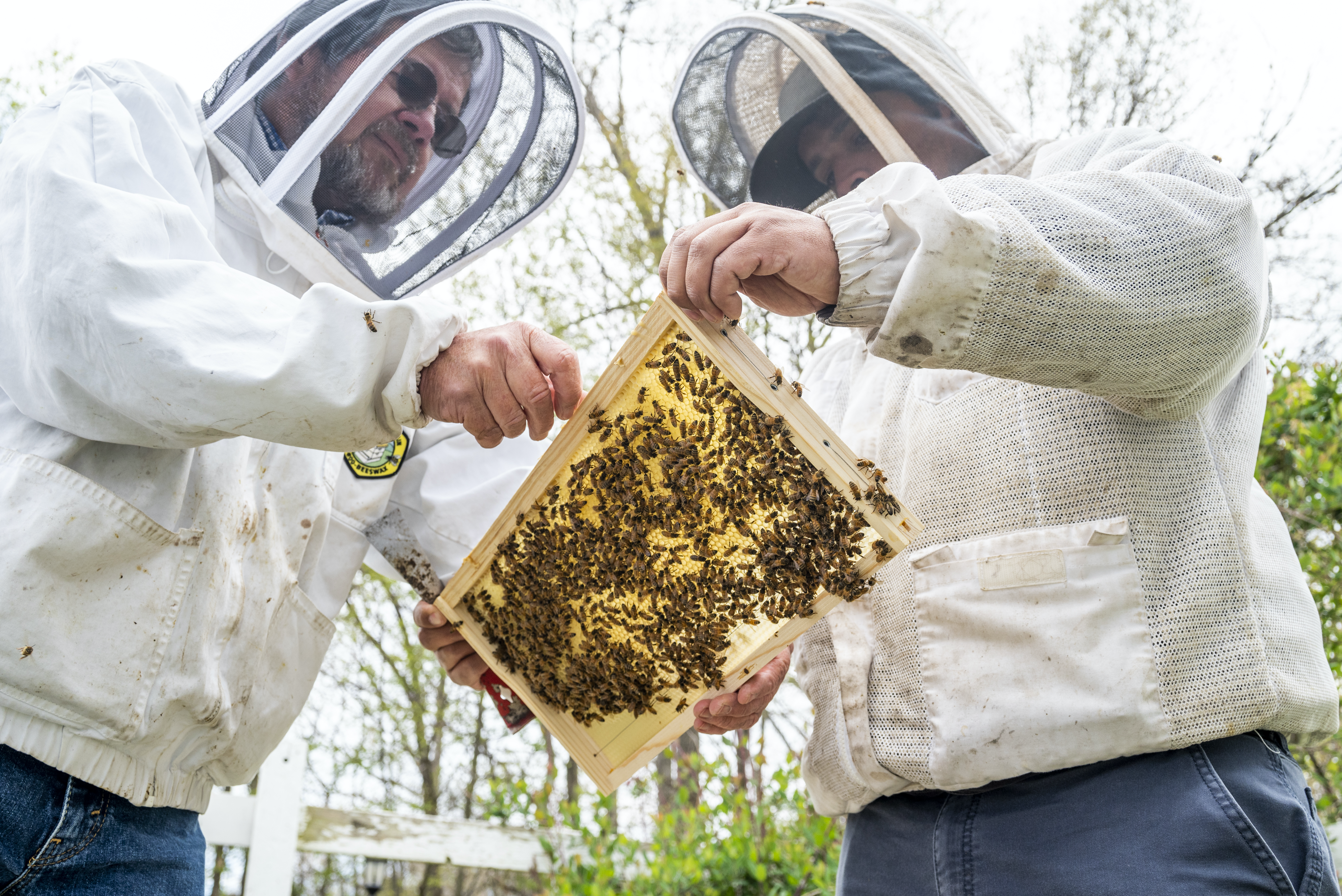
The George Mason University Honey Bee Initiative (HBI) empowers communities through sustainable beekeeping. HBI’s work is community-driven, multi-disciplinary, and responsive to the United Nations Global Goals.

Ongoing Projects
VR Field Trip
Points of Contact: Lisa Gring-Pemble (PI), Carley Fisher-Maltese (Co-PI)
Funded by Daniel Price, President and CEO of the Sweet Virginia Foundation, this new STEM learning tool is a collaborative venture at Mason, bringing together faculty, staff, and students from the School of Business, which houses the George Mason University Honey Bee Initiatiave, the College of Education and Human Development (CEHD), and the College of Engineering and Computing (CEC). Through an immersive nine-minute video, young students in Northern Virginia will take a “field trip” to a Mason apiary, learning from an expert beekeeper, taking a deep dive into a hive, and even flying like foraging honey bees. The video was designed to enhance existing pollinator curricula taught in fourth grade classrooms, and foster interest in STEM and STEM careers in today’s youth.
The 360 video features Sarah Red-Laird, who is the founder and director of The Bee Girl Organization, which is widely known for teaching kids, beekeepers, and farmers how to “love their bees,” and students from Willow Springs Elementary School in Fairfax, Virginia. The video was created by CreatorUp!, a California-based video production company.
Future Directions: After we complete testing of the video in October, 2022, we plan to create additional videos and to integrate the video in classrooms throughout the country.
Forensic Science Project
Point of Contact: Joseph Dizinno
The GMU Forensic Science Program plans to utilize the GMU Forensic Research and Training Laboratory to perform forensic research with bees as a possible aid to investigators searching for buried/hidden human remains.
Future Directions: There are two approaches to forensic bee research which the GMU Forensic Science Program intends to pursue:
1) By including the expertise of the GMU Center for Applied Proteomics and Molecular Medicine, proteins present in the honey from bees whose hives are located near the GMU Forensic Research and Training Laboratory will be analyzed to determine if changes in the protein content of the honey obtained from hives in that area may help to indicate the presence of human remains.
2) Our preliminary research indicates that it may be possible to train bees to assist investigators in locating human remains. The GMU Forensic Science Program will also explore the utilization of bee training to possibly assist investigators in the location of human remains.
Pollen Collection and Analysis
Points of Contact: HC Lim, Bill Hahn, and Lisa Gring-Pemble
The objective of the project is to determine plant species used by honey bees as they collect pollen from the area surrounding each hive. This project combines DNA barcoding, and counting or high-throughput imaging of pollen to determine their abundance. Team members include Dr William Hahn, Dr Lisa Gring-Pemble and OSCAR students. The project has been completed and Dr Lim is expanding the project to include bumble bees and the use of next-generation sequencing. The project uses hives on campus and outside of campus, and will shed light on whether bee colonies are sufficiently resourced during critical periods of their yearly cycle.
For insight into how students might work on this project, see the work of undergraduate student Quentin Jamison, who under the supervision of HC Lim conducted studies of pollen to see if pollen could be used as a way to identify plants.
HBI Apiary Expansion with Support from the O’Shaughnessy-Hurst Memorial Foundation
Points of Contact: Lisa Gring-Pemble and Andrew Garavito
With funds from the O’Shaughnessy-Hurst Memorial Foundation, our goal is to scale to 200 hives in a manner that also allows us to accomplish the following key objectives:
- Establish and maintain an adequate number of hives (5-10) on two campuses (Fairfax and Prince William’s Science & Technology) for research and education purposes
- Establish and maintain an adequate number of hives (~10) at the Lorton Landfill site to allow for continued data collection and analyses on how bee health is impacted by factors such as the presence and impact of heavy metals, chemical pollutants and pesticides in the air, water or soil, and how we might remediate the effects these have on bees and by extension humans.
- Establish and maintain an adequate number of hives for splitting and queen rearing (10-20) so that we build our own, in-house, capability and processes to replace the natural losses of bees during winter month, as well as other year-to-year losses typical of beekeeping.
- Dedicate the remaining hives (150-160) for honey and wax production and processing, and developing marketable products that will generate income sufficient to support the project as a self-sustaining enterprise.
- Develop a social business model whereby we have the tools, knowledge, and investment resources to establish small scale businesses in rural and poor urban communities. We endeavor to have each such small business employ 2-3 people, produce local honey and related products for community consumption and continue to educate about the importance of pollinators.
Future Directions: We are expanding the number of hives and welcome students and faculty with an interesting in maintaining the hives on a regular basis.
Greenhouse & Gardens Program, University Sustainability, Facilities Administration
Point of Contact: Doni Nolan
Doni Nolan, manager of the Greenhouse & Gardens Program, and her team of four part-time staff are working year-round to design and maintain several gardens and projects that support pollinators on campus. This includes landscaping around the honeybee hives and student-led projects that create bee hotels for native pollinators. Visit green.gmu.edu to learn about getting involved with University Sustainability.
National Science Foundation, Future of Work Grant
Points of Contact: Carley Fisher-Maltese and Lisa Gring-Pemble
We face an emerging and worsening crisis around pollinators (US Pollinator Report, 2015). Traditional approaches to beekeeping have been unable to stem the tide of colony collapse, which has placed stress on the beekeeping workforce. While summer losses have held steady at 20.5%, winter loss figures for 2020 were up 8.9% over the average winter loss (2006-2019). The loss of honeybees impacts both food security and national security. Given this context, the future of work for beekeeping will involve mastering research-driven practices (Kulhanek et al, 2017) that respond to bee health in different landscapes (Patel et al., 2020), and that deploy sensors (Catania & Vallone, 2020;). In this planning grant, we focus on a solution related to design and deploy sensor-supported urban beekeeping (Catania & Vallone, 2020).
This project: (a) deployed sensors in hives to generate data colony health as monitored by measurement; (b) developed cloud computing capacity to integrate the hive sensor data with field data to scientifically describe pollinator and ecosystem health; and (c) developed K-12 STEM- and Data Science-related education and beekeeping career connections. Following are two projects that are part of this NSF grant.
Long-Term IOT-Enabled Temperature Monitoring within a Bee Hive
Points of Contact: Nathalia Peixoto (PI [email protected]) with Franklin Farrel, Mechanical Engineering, Lisa Gring-Pemble, School of Business, Carley Fisher-MalteseCollege of Education and Human Development, Daniel Lofaro, Daniel, Electrical Engineering, and Maria Bouga, Maria, Laboratory of Agricultural Zoology and Entomology, Agricultural University of Athens, Greece Peixoto, Contact: [email protected]
In order to track and predict the health of beehives there have been several sensor systems suggested and deployed in the last decade. Most sensor systems target one modality (either temperature, weight, or light) and have a single point (one sensor) that is used per hive. In order to advance the field and to provide a more consistent and detailed profile of variation within a hive throughout the different seasons of the year, we have designed and tested a long-term, multisensor modality solution that can be easily integrated in any apiary. We propose an “internet-of-things”-enabled sensor array powered by solar panels. The array includes carbon dioxide sensors, temperature sensors, accelerometers, and force sensors (for weight). Our design includes Raspberry-Pi boards and can transmit real-time data over a wireless network. In this paper we present results on a four-month long experiment spanning winter and spring, with recordings from six temperature sensors that connect through a serial port, I2C. The digital sensors are MCP9808, by Microchip, and have accuracy of 0.5 degrees C. We mounted them on custom-designed two-layer printed circuit boards. The three top sensors are 8 cm apart (center-to-center distance) and the lower sensors are 10 cm below the top 3. Our deployed system logs data approximately every 6 continuously in ASCII-formatted files. We then make the recorded data available for 24-hour increments. The recorded data are time stamped accordingly and can be easily manipulated to plot six profiles for each day. We have deployed one sensor array and tracked temperature variations as described above from January, 2022 through June, 2022. By plotting graphs from our recorded data, we are easily able to show bees thermally managing their hive. For example, in the January and February there is up to a 20-degree Celsius difference between sensors. In conclusion, we have designed and deployed a sensor array that provides temperature profiles inside the beehive uninterruptedly for months. We intend to expand this work to include multiple hives and other sensors, in order to more fully investigate the dynamics of bees throughout the year.
Smart Hive Project
Point of Contact: Craig Yu
Prof. Yu, Master Beekeeper, Andrew Garavito, and Yu’s students are devising a smart hive with a 360 camera embedded. The system, based on a Raspberry Pi, would allow streaming of the 360 video of the inside of the hive which could then be viewed in VR / through a web browser. The system can be remotely controlled; for example, an operator can log into the system remotely to control the light inside the hive. We will also explore other functionalities.
K-12 Education and the HBI Apiary
Point of Contact: Carley Fisher-Maltese
CEHD Early Childhood Education undergraduate and graduate students enrolled in ECED 4/516: Science for Diverse Young Learners visit the apiary regularly to learn about the honey bees first hand. The bees demonstrate a wonderful convergence of animal anatomy, behavior, life cycles, and human impacts on the natural world.
First graders from a local public school visited the apiary to observe the honey bees and engage in hands on learning experiences.
K-8 students from a local private school participated in a pollinator celebration in collaboration with Mason HBI.
